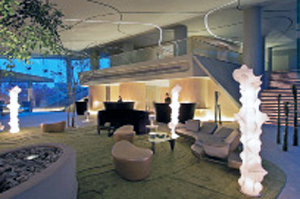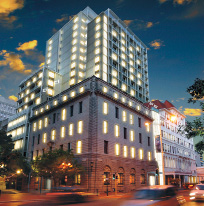- Home
- Media Kit
- Current Issue
- Past Issues
- Ad Specs-Submission
- Ad Print Settings
- Reprints (PDF)
- Photo Specifications (PDF)
- Contact Us

![]()
ONLINE

The Taj Touch
Editors’ Note
Raymond Bickson began his career at the Hilton Berlin in 1973. Following worldwide managerial postings, predominantly with Regent International Hotels of Hong Kong and Monaco’s Rafael Group, he joined The Mark in New York in 1988, where he served as Vice President and General Manager until assuming his current post in 2003. Bickson studied in Berlin, Paris, Lausanne (Switzerland), and at Cornell and Harvard Universities.
Company Brief
Mumbai-based Taj Hotels Resorts and Palaces (www.tajhotels.com), recognized as India’s largest and finest hospitality chain, was founded in 1903. Owned by the Tata Group, it consists of more than 60 properties located throughout the subcontinent, as well as in southern Asia, the Middle East, Africa, New York, Boston, and London. In addition to its luxury hotels in India (several of which are members of The Leading Hotels of the World), the group operates business hotels, palace hotels, beachfront resorts, and garden retreats.
How has the global economic downturn affected the travel and tourism business in India?
The global downturn led to a drop in tourist arrivals in the first half of 2009, and all players have been impacted. However, the recent months do show a slow but definite revival, although the economic difficulties will continue to affect where and how people will travel and stay. The current trend of downgrading of airlines and hotels will continue. Companies will continue to look for ways to cut costs, which will have an impact on our business. Customer priorities have undergone a change with this economic crisis and their concerns are more personal, emotional, and ethical. As hoteliers, we need to realign in order to address these needs.
The outlook for the future is positive, and most companies are once again actively planning for the long term. The foreign tourist arrivals, which had dropped post-November 2008, actually witnessed a one percent year-on-year (YOY) growth in July 2009. Although the trend has reversed in subsequent months due to the H1N1 scare, the pace of deceleration has slowed and we find this very encouraging. Air traffic volumes across both domestic and international traffic have also shown sharp signs of recovery. As of August 2009, domestic traffic grew by 22 percent YOY and international traffic grew by 6 percent YOY. Keeping all these trends in mind, we expect that travel and tourism in India will show satisfying levels of growth going forward.

Vivanta by Taj – Whitefield, Bangalore lobby
What new developments is Taj planning?
We have extensive development plans across India. In a short while, we will be opening the iconic Falaknuma Palace hotel, which is the fourth luxury Palace property operated by the Taj Group in India; we have extensive plans for our Vivanta brand of hotels, with three Vivanta projects ongoing in Delhi – one in Bangalore, one in Coimbatore, in Bekal and in Pondicherry; and two more Vivantas are in the pipeline in Guwahati and Amritsar. There are extensive development plans for the Gateway brand as well, growing through management contracts. Several management contracts have already been signed for the Gateway properties across India.
Internationally, the focus on growth continues. The company will soon be launching a new luxury hotel in Cape Town. Management contracts have been signed and design progresses for its new properties in Doha, Dubai, Beijing, and Hainan Island. The company’s new Taj Exotica project in Phuket is slowly taking shape and a mock up room has been undertaken. We also have management contracts in Abu Dhabi, Ras Al Khaimah, and Tangiers, and are in active negotiations for properties in Egypt and Marrakech.
You recently re-launched The Pierre in New York after a major renovation. Would you provide an overview of the property?
The Pierre is our flagship luxury hotel in the international market. As per our strategy of getting into the international markets only with luxury brands, The Pierre plays a significant role in the luxury positioning of the Taj in one of our most important source markets – the U.S. First opened in 1930, this iconic Beaux Arts flagship property of Taj reopened on June 1st, 2009, following an impressive investment in renovation of over $100 million. The brand is focused on creating unique and impeccable moments for guests, which balances the very best of traditional and contemporary Indian hospitality to create unique experiences and life-long memories for all guests.

Taj Cape Town
Many hotel groups today have placed a major emphasis on offering high-end spa/fitness facilities. How much of a focus has this been for Taj Hotels?
Yes, a distinguishing spa concept is the USP of any hotel brand across the world. In 2003, before other Indian hotel chains had made this a priority, we conceptualized our own in-house brand, Jiva. As an Indian hotel company in a land rich in culture, tradition, and the bedrock of Asian healing traditions, we decided to capitalize on an untapped market idea.
Jiva is unparalleled in the global spa industry. This award-winning spa brand not only offers unique Indian spa treatments, but our oils and blends are composed of handpicked organic ingredients, especially created for Jiva from a botanical source, free from parabens and petrochemicals, and not tested on animals. Treatments are offered at Jiva Spas using unique products made from pure Indian herbs, exclusively hand-blended Indian aromatherapy oils, natural creams, and special ingredients, each having its own distinct attributes. Our spa linen and clothing use natural fibers, organic cotton, silk, and wool that are dyed by directly immersing them in herbs. The natural cottons are sun-bleached. Our entire line of pottery is toxin-free and completely eco-friendly, handmade on a potter’s wheel. Every product used in our spa brand is bespoke.
As you look to 2010, what are the key priorities that you are focused on for the brand in order to make sure that you retain your leadership position in the industry?
Our focus is to roll out the new brand architecture, which will clean up the Taj Hotels Resorts and Palaces portfolio and lay down the relationship between the parent brand and all other brands in the portfolio in a clear and cohesive fashion; to further strengthen the brand in key international markets, like the U.S., U.K., Europe, and others; to deliver unique experiences and brand promise across all hotels, both for a leisure and business traveler, as increasingly, the customer has less time and more expectations; and to offer sharply differentiated products across various market segments in order to be able to tap into the growing upper upscale and upscale segments, as well as to provide a product that is relevant and differentiated on the basis of the psychographic profile and needs of the new evolving customer.